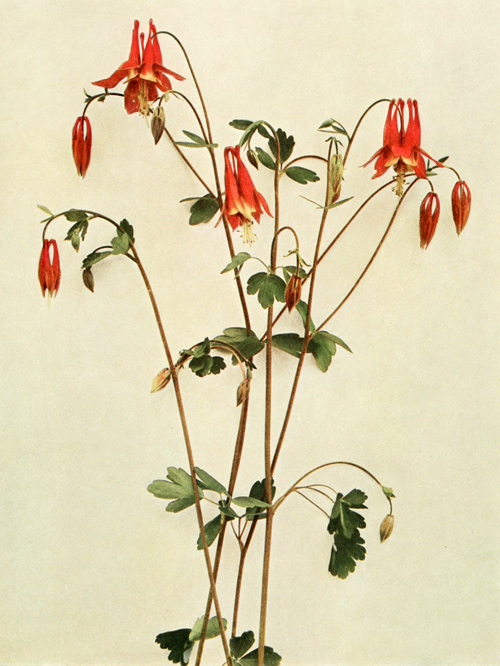At Fort Mandan near present Stanton, North Dakota, fresh elk meat finally arrives. The enlisted men continue working on the fort’s interior, and Lewis adds Canada columbine seeds to his plant collection. Arikara chief Too Né describes the seed’s traditional uses.
ChinkdeChink, Daub Daub
by Yellowstone Public Radio[1]Originally aired weekdays by Yellowstone Public Radio during the Bicentennial observance of 2003-2006. Narrated by Hal Hansen. Scripts by Whit Hansen and Ed Jacobson. Produced by Leni Holliman. © … Continue reading
Canada Columbine (1918)
Aquilegia canadensis
Wild Flowers of New York Part 1, University of the State of New York, State Museum, Albany. Homer D. House, New York State Botanist. Walter B. Starr of the Matthews-Northrup Company, Buffalo, and Harold H. Snyder of the Zeese-Wilkinson Company, New York, photographers.
Fresh Elk Meat
a cold clear morning. the frost fell from the trees by the Sun Shineing upon them. at 11 o.C. the frenchman arived with a fat Elk from our pearogue [pirogue]. we have worked Several evenings back to make our Sevels comfotable. the party all moved in to the huts
—John Ordway
Canada Columbine Seeds
No. (100) Novr. 17th the seed of a plant given me by the recaray [Arikara] chief [Too Né (Eagle Feather)] who accompanyed us to the mandanes [Mandans] he informed me that a tea of the seed was a strong diaerettic— and that the squaws chewed them and rubed their hair with them as a perfume.
—Meriwether Lewis, Fort Mandan Miscellany
Moulton identifies these lost seeds, received by John Vaughn in 1805 (see The Donation Book), as Aquilegia canadensis, Columbine.[2]Gary E. Moulton, ed. Journals, “Fort Mandan Miscellany”, vol 3:460, 471.
Weather Diary
Ther. at rise
Weather Wind at rise
Thert. at 4 P.M. Weather Wind at 4 P.M. River 28 fair S. E 34 fair S E rise ¼ in. the frost of yesterday remained on the trees untill 2 P. M. when it descended like a shower of snow— swans passing from the N.
—Meriwether Lewis[3]To assist the reader, the editor of this web page has omitted the date column, merged the “River” columns, and spelled out some abbreviations.
Fort Mandan is a High Potential Historic Site along the Lewis and Clark National Historic Trail managed by the U.S. National Park Service. The North Dakota Department of Parks and Recreation manages a modern reconstruction and the Lewis and Clark Interpretive Center located at US Hwy 83 and ND Hwy 200A.
Knife River Indian Villages National Historic Site is a High Potential Historic Site along the Lewis and Clark National Historic Trail managed by the U.S. National Park Service. A unit of the National Park System, the site is located at 564 County Road 37, one-half mile north of Stanton, North Dakota. It has exhibits, trails, and a visitor center.
Notes
| ↑1 | Originally aired weekdays by Yellowstone Public Radio during the Bicentennial observance of 2003-2006. Narrated by Hal Hansen. Scripts by Whit Hansen and Ed Jacobson. Produced by Leni Holliman. © 2003 by Yellowstone Public Radio. |
|---|---|
| ↑2 | Gary E. Moulton, ed. Journals, “Fort Mandan Miscellany”, vol 3:460, 471. |
| ↑3 | To assist the reader, the editor of this web page has omitted the date column, merged the “River” columns, and spelled out some abbreviations. |
Experience the Lewis and Clark Trail
The Lewis and Clark Trail Experience—our sister site at lewisandclark.travel—connects the world to people and places on the Lewis and Clark Trail.
Discover More
- The Lewis and Clark Expedition: Day by Day by Gary E. Moulton (University of Nebraska Press, 2018). The story in prose, 14 May 1804–23 September 1806.
- The Lewis and Clark Journals: An American Epic of Discovery (abridged) by Gary E. Moulton (University of Nebraska Press, 2003). Selected journal excerpts, 14 May 1804–23 September 1806.
- The Lewis and Clark Journals. by Gary E. Moulton (University of Nebraska Press, 1983–2001). The complete story in 13 volumes.




